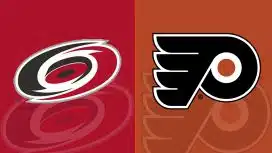By Kevin Durso, Sports Talk Philly editor
Following back-to-back losses in ugly fashion to the Islanders and Penguins to close out October, there wasn’t really a game on the early November schedule that didn’t appear to be a test for the Flyers.
The Flyers win over the New Jersey Devils two weeks ago came just before the Devils started to slide into a string of three losses in their last four games. But from there, to play Toronto twice, Carolina, Montreal and Boston and survive it all with points in all five games was already an accomplishment. This week presented two more challenges. One of them is to come on Saturday when the Islanders pay a visit. The other was Wednesday night’s game against the Washington Capitals, the NHL’s best team in the early part of the season.
Here are just a few facts for you from this game. It was the first time all season the Capitals didn’t score a goal in the second period. It was also the first time since Oct. 5 that the Capitals didn’t score at least three goals.
Think about that. The Capitals have dismantled teams left and right. They entered the game on a 12-game points streak. They had scored at least four goals in six straight games before a 4-3 shootout loss on Monday to Arizona. And the Flyers somehow held them to one goal over 65 minutes of action.
The result may have been a 2-1 shootout loss for the Flyers, snapping a four-game winning streak, but it was once again a small moral victory early in the season, a game where they at least showed they can hang with a top contender in the league.
Here are some more observations from Flyers-Capitals.
The First Period
Make no mistake about it, the Capitals were clearly the better team in this game. They showed it right from the start. The Capitals had seven of the first eight shots in the game and outshot the Flyers, 16-5, in the opening period. They took a 1-0 lead on a rebound goal by Brendan Leipsic with leading scorer John Carlson setting things up with a good shot from the blue line.
It was clearly noticeable that the Capitals were excelling in the first 20 minutes because of their speed. The Flyers just couldn’t keep up collectively and what was alarming, at least in the early going, was that not even their best and most consistent line of the season was standing out.
“In the first period we were a step behind, a second behind,” head coach Alain Vigneault said. “Give them credit I mean they came out hard and they proved in that first period there’s a reason why they’re first in the league right now. Their execution and their speed was very challenging.”
“They gave it to us in the first. That wasn’t how we should have come out,” Kevin Hayes said. “We came in here and realized that that isn’t how we are supposed to play. In the second and third, we tilted the ice their way and played the correct way.”
There was a common theme to the Flyers previous four wins. They had scored first in each. In each of the last three games, they had taken 2-0 leads. The task becomes increasingly difficult when you face elite goalies like Braden Holtby and appear to be chasing the opposition from the start.
Things did tighten up for the Flyers over the remainder of the game and that certainly made for entertaining hockey, but the Flyers were far outmatched in the opening period, and the only reason they were even in the game was because of the next observation.
Carter Hart
Carter Hart was involved in another classic goalie duel and this time, he was the one making more saves and at a higher difficulty.
There was really no one around Leipsic that would have made his rebound chance any easier for Hart to stop and from point-blank range like that, there just isn’t much Hart can do.
Hart had his moments. He left a couple of bad rebounds throughout the remainder of the game, but recovered to make the saves he needed too. But overall, he was just sharp once again. His glove hand was solid. His tracking remained on point. There were a few moments where play got frantic in front of his crease and he was able to maintain control and keep the puck out.
Despite going 0-for-2 in the shootout, Hart was the reason the Flyers were able to stay within striking distance and nearly come away with the win.
Line Shuffling
After a rough first period, the Flyers started to shorten the bench in the second. It started with random shuffling between all four lines. Tyler Pitlick took a shift with Claude Giroux and James van Riemsdyk. Joel Farabee was dropped down to the fourth line for a while before being back on the top line and the top power play.
By the middle of the second period, the line combinations had been shuffled again and the Flyers were using only nine forwards on a heavy rotation with a few shifts for the fourth line thrown in.
The trio of Farabee, Andy Andreoff and Carsen Twarynski saw limited ice time as the game went on. Farabee had just one shift for 52 seconds in the third period, though he still finished with 11:51 of ice time. Andreoff finished with just 5:40 of ice time, and also got a 52-second shift in the third period. Twarynski had just 6:55 of ice time and did not play after the second period.
“We battled hard, we competed hard tonight. It wasn’t easy, we had a few guys that were giving us an A effort but their execution wasn’t what it could be but they were working hard and I shortened the bench I want to say half way through the game there,” Vigneault said. “Sometimes you’ve just got to do it that way, you’ve got to grind it out, find a way and that’s what we did tonight.”
Vigneault noted that Farabee was one of those players, indicative of his ice time, but said that he would be right back out there the next game.
Power Play Comes Up Big
The Flyers had been 0-for-3 on the power play when another opportunity arrived with 13:45 remaining in the third period. This was the chance to even things back up.
The Flyers have seen the second unit have success and a lot of different contributors on the power play early, but there has been a lot to be desired from the top veterans. In these situations, you rely on them to give you the spark you need.
Enter Jake Voracek, who made a great entry and put a nice move on former teammate Radko Gudas. That created a mini two-on-one, and Voracek fed Giroux with a pass that he was able to bury through the five-hole of Holtby.
The Flyers really deserve credit for a strong special teams game. The first three power plays weren’t great, but Washington is one of the top penalty killing teams in the league. It wasn’t a surprise that the Flyers were struggling to get sustained pressure there. But the penalty kill was another story.
The Flyers were 3-for-3 on the night on the penalty kill against the unit that has always had success. The Capitals had entered the game with a power-play goal in four of the last six games. Everyone who watches hockey, even on the most limited level, knows they like to eventually work the puck to Alex Ovechkin for the one-timer from the left circle. He never got a sniff.
Instead, there was a lot of perimeter play trying to find that opportunity, and while the Capitals certainly got their chances on the power play, Hart stood tall when he had to.
Overtime Again?
Make it four straight games and six of the last seven that have required overtime for the Flyers. It’s the first time since the onset of overtime in the 1983-84 season that the Flyers have reached overtime in six of seven games.
Getting to overtime can be interpreted in many ways at different points in the season. You can survive for longer in the playoff race by getting to overtime frequently and stringing together games with points early, but as the season gets to the critical games in February and March, you need to start winning in regulation. You also want to take care of business in regulation as much as you can against teams within your conference and especially your divisions.
The thing about getting to overtime and settling for the loser point is that it is only settling if you don’t come away with the result. The previous three wins for the Flyers have all gone to overtime and two to a shootout. While results in regulation and overtime do help with tiebreakers, the more points you can get early, the better.
When you go the distance and play 65 minutes in a 1-1 tie to earn a point against the NHL’s best team in mid-November, you take that result every single time.
It’s not a habit you want to get into regularly. But in games against the best teams in the league like Washington on Wednesday or Boston on Sunday, getting the game to overtime, especially for this team, is an accomplishment.







